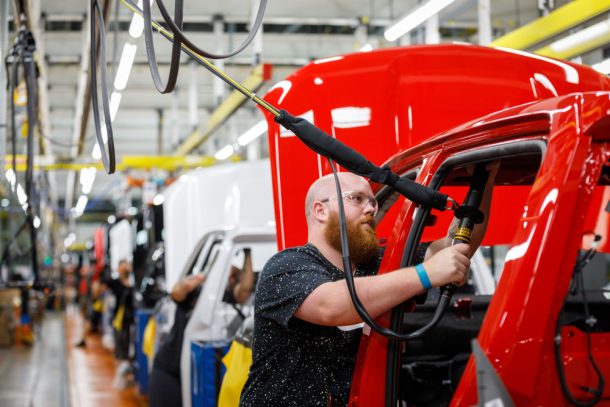John Gress Media Inc/Shutterstock
” data-medium-file=”http://lntransportation.net/wp-content/uploads/2020/08/detroit-wrapping-on-ventilator-production-returning-to-cars-2.jpg” data-large-file=”http://lntransportation.net/wp-content/uploads/2020/08/detroit-wrapping-on-ventilator-production-returning-to-cars.jpg” class=”aligncenter size-large wp-image-1733216″ src=”http://lntransportation.net/wp-content/uploads/2020/08/detroit-wrapping-on-ventilator-production-returning-to-cars.jpg” alt width=”610″ height=”407″ srcset=”http://lntransportation.net/wp-content/uploads/2020/08/detroit-wrapping-on-ventilator-production-returning-to-cars.jpg 610w, http://lntransportation.net/wp-content/uploads/2020/08/detroit-wrapping-on-ventilator-production-returning-to-cars-1.jpg 75w, http://lntransportation.net/wp-content/uploads/2020/08/detroit-wrapping-on-ventilator-production-returning-to-cars-2.jpg 450w, http://lntransportation.net/wp-content/uploads/2020/08/detroit-wrapping-on-ventilator-production-returning-to-cars-3.jpg 768w, http://lntransportation.net/wp-content/uploads/2020/08/detroit-wrapping-on-ventilator-production-returning-to-cars-4.jpg 120w, http://lntransportation.net/wp-content/uploads/2020/08/detroit-wrapping-on-ventilator-production-returning-to-cars-5.jpg 1000w” sizes=”(max-width: 610px) 100vw, 610px”>
General Motors and Ford Motor Company are about to conclude their prolonged stint of ventilator production. In case you were unaware, these businesses typically manufacturer automobiles (cars, for the layperson) and have allocated a portion of their factory space to build medical equipment that was assumed to be useful during the pandemic. However, the United States now has more ventilators than it knows what to do with, and most of them seem like they won’t be required — so it’s mission accomplished, unless COVID-19 suddenly becomes a much more vicious illness.
Either way, GM and Ford both plan to re-prioritize vehicle production. The Blue Oval moved core staff off ventilator lines and back to their normal places of assembly months ago. Some of the remaining temporary workers hired to assist with the medical equipment are said to have an opportunity building the new Ford Bronco. Meanwhile, GM says it wants to move ventilator production to a facility in Kokomo, Indiana, next month, where it will hand operations over to Ventec Life Systems as it regains the union employs allocated for the project. Temporary hires will be absorbed by Ventec.
According to Reuters, GM and Ventec are in the last leg of completing their joint contract to deliver 30,000 critical care ventilators by the end of August under a $489 million contract with the federal government. Ford has reportedly assembled around 47,000 of the 50,000 ventilators it agreed to supply with help from General Electric Co. That contract is worth roughly $336 million.
From Reuters:
[Health and Human Services] said it has received more than 69,000 ventilators assembled by GM, Ford and their partners, and “both of these delivery schedules are nearly complete.”
Ford and GM earlier this year said they would employ a total of as many as 1,500 people on ventilator assembly lines. Automakers likened the efforts to their switch from making cars to tanks and planes during the Second World War.
While roughly 12,000-15,000 ventilators have been issued to U.S. hospitals, the Health and Human Services (HHS) department reported that the government has nearly 110,000 ventilators stockpiled. While President Trump suggested a large portion of those will be issued to other countries in need, demand has come down immensely. We know the United States shipped heaps of personal protective equipment to China before COVID-19 officially became a global pandemic, and that the plan was to continue doing so while incorporating breathing machines (though the latter would not be donated) once the U.S. had a reliable supply for itself. It was also made clear that other nations would be given priority, as Trump said he planned to donate 200 to the United Kingdom in April.
But treatment strategies changed.
Invasive ventilators have been replaced with sleep apnea machines for at-risk patients or simply rolling them onto their sides and giving them helpful prescriptions. The HHS also confessed that the U.S. probably never needed quite so many units as were being manufactured. “States initially requested far more ventilators than they actually needed,” an HHS spokeswoman explained, adding that orders were placed at at time where the nation had more questions than answers.
Even though ventilators are being taken off the table at automotive plants, the industry will still manufacture personal protective equipment (masks, face shields) for the foreseeable future. Demand for PPE has not diminished in the slightest, and the situation is unlikely to change while face coverings are still required to interact with the public. It’s a situation we don’t see changing, even as Sweden (a country that went largely mask-free, didn’t do lockdowns, and still avoided mass contagion) has started to claim that masks are effectively useless against the virus. The rhetoric is quite different here, though not terribly distinct from most first-world nations that wanted to exercise the maximum amount of caution.
Presidential candidate Joe Biden recently said that “every governor should mandate mandatory mask wearing” and recommended their continued use until at least November of this year. The right has been more flippant about the usefulness of face coverings in general, but even President Trump offered his own tepid endorsement this summer.
We figure this will result in automakers tossing together masks until at least 2021, though the demand this places on companies is much lower than ventilator manufacturing and shouldn’t interfere with the core business of automakers.
[Image: John Gress Media Inc/Shutterstock]

